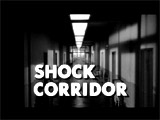
|
Shock Corridor (1963)
In writer/director Samuel Fuller's raw B-movie, a psycho-drama
with shocking, exploitative subject matter (xenophobia, racism, hate
and violence), and using the setting of a madhouse as a harsh commentary
upon Cold War America:
- the pre-title credits quote from Euripides, 425
BC: "WHOM GOD WISHES TO DESTROY HE FIRST MAKES MAD"
- the opening voice-over narration, seen as an iris
opened onto the corridor ("The Street") of a mental hospital
(extended at the end of the corridor by a matte painting): "My
name is Johnny Barrett. I'm a reporter on the Daily Globe.
This is my story as far as it went"
- the ambitious and slightly crazy scheme of newspaper-tabloid
reporter Johnny Barrett (Peter Breck) to pretend to be a madman,
in order to solve a murder in an insane asylum, and win the Pulitzer
Prize: ("Every man wants to get to the top of his profession.
Mine is winning the Pulitzer Prize"); Barrett received approval
from his publisher "Swanee"
Swanson (Bill Zuckert) and psychiatrist Dr. Fong (Philip Ahn), and
then had to convince his very reluctant stripper girlfriend Cathy (Constance
Towers) to pose as his 'sister' and claim that he had an incestuous
interest in her in order to be committed; she thought his idea was
insane: ("Johnny, you've got to be crazy to want to be committed
to an insane asylum to solve a murder") and prophetically warned: "Their
sickness is bound to rub off on you," but he assured her: "Those
lunatics are not gonna get to me"
- Cathy's spouted harsh statements about her profession
as an exotic dancer, all to save money for their life together:
"Johnny, I'm in love with a normal reporter holding down a normal
job...Do you think I like singing in that sewer with a hot light on
my navel? I'm doing it because it pays more than shorthand or clerking
or typing...I'm saving money so we can have that normal life. That's
all I want, but I'm scared...I'm scared this whole Jekyll-Hyde idea's
going to make a psycho out of me"; when he became derogatory about
her fears, and called her stripper joint a 'dive', she struck back
defensively: "That dive is holy compared to your ideas of work.
Hamlet was made for Freud, not you!"
- the expressionistic scene of Cathy performing a provocative
onstage striptease (before a backdrop of cheap tinsel hearts and
an unseen audience that applauded off-screen when she concluded),
with her face first completely covered by a feather boa, as she sang
the ballad: "Someone to Love" (referring to Johnny); afterwards,
she sat in front of her dressing room mirror (with a picture of Johnny
in the corner), haunted by her earlier fears of Johnny's scheme
- the scene of Barrett's initial emergency admission
interview with the county hospital psychiatrist Dr. J. L. Menkin
(Paul Dubov), when Johnny admitted his incestuous desire and an alleged
attack on his 'sister' Cathy (and to play along, she had signed a
formal complaint); he had to be physically restrained when he assaulted
Menkin
- after being admitted as possibly having "borderline
psychosis," the hallucinatory scene of miniature naughty stripper
Cathy performing a feather-boa dance on Johnny's shoulder and tickling
his ear while he was sleeping; she acted enticingly: ("The drama
critic on your paper said my Chablis-tinted hair is like a soft halo
over wide-set inviting eyes. And my mouth, my mouth was a lush tunnel
through which golden notes came....And my movements evoke the most
inflammatory passions in all...I don't like being alone, Johnny,
but you made me be alone, Johnny. And I have a right to find another
Johnny"); he murmured back: ("My yen for you goes up and
down like a fever chart"); in Cathy's second hallucinatory appearance,
she assured him: "All of the men want me, Johnny, but I want
you. And you - you want the Pulitzer Prize" (she again began
singing "Somebody to Love")
- the expressionistic, claustrophobic sets portraying
the inside corridor of an insane asylum (symbolic of America), where
Barrett was finally committed; he beamed: "I made it, I'm in!...And
this long corridor is the magic highway to the Pulitzer Prize"
- the scene of the attack of lurking females on Barrett
when he became locked inside the nymphomaniac ward (one was singing "My
Bonnie Lies Over the Ocean"); he was surrounded and then wrestled
to the ground and injured - (earlier, one of the attendants had warned
him: "I used to work in the female wing, but the nympho ward
got too dangerous for me")
- in order to investigate the unsolved butcher knife
stabbing of Sloan that had occurred in the asylum's kitchen, the
three interview scenes with crazed inmates (who witnessed the crime),
in order for Barrett to decipher the murderer's identity - each represented
a major problem in the post-war US - xenophobia, racism, and nuclear
war: (1) deranged and bigoted Communist-hating, ex-GI Korean War
veteran Stuart (James Best) who believed he was
"Dixie"-loving, Civil War Confederate General Jeb Stuart
(he had been captured as a POW and brainwashed by Korean communists,
then returned, was dishonorably discharged from the US military, and
ostracized), (2) another insane patient named Trent (Hari Rhodes) -
a black civil rights pioneer (he had been the first Negro student to
integrate into a Southern university: "a guinea pig in a classroom")
who now crazily carried a sign: ("Integration And Democracy Don't
Mix"), and believed he was the white supremacist, Grand Wizard
founder of the Ku Klux Klan, and (3) guilt-ridden, brilliant American
nuclear scientist-physicist Dr. Boden (Gene Evans), a Nobel Prize winner
who helped build the atomic bomb (who regressed and believed he was
an innocent six-year old boy, playing hide-and-seek and drawing with
crayons); each of the interviews followed a pattern - a delusion, a
dreamy hallucination in color (amateurish 16mm footage) - in two cases,
and a very brief moment of sanity
- the scene of black inmate Trent - believing that he
was a white supremacist Klan leader with a white pillowcase hood
- standing on a bench, and delivering an incendiary hate-filled,
racist rant about returning America to Americans: "If Christ
walked the streets of my hometown, he'd be horrified. You've never
seen so many black people cluttering up our schools and buses and
cafes and washrooms! I'm for pure Americanism! White supremacy! Listen
to me, Americans. America for Americans. We got to throw rocks and
hurl bombs. Black bombs for black foreigners. So they like hot music,
do they? Well, we'll give them a crescendo they'll never forget.
Burn that freedom bus. Burn those freedom riders! Burn any man who
serves them at a lunch counter. Burn every dirty, nigger-lovin' pocketbook
integrationist! Collect a lot of blackjacks and good long lengths
of pipe. We'll show those rabble-rousers they can't breathe our white
air, and go to school with our white children. We'll get some infallible
liquid and pour it on 'em. We'll pour it on their homes and burn
'em. Pour it on their pickaninnies and set them on fire. Call out
the members of the White Citizens Council. Call out the KKK! Yes,
we'll sponsor the Africans north! Get rid of every black mother,
son and daughter! America for Americans...Keep our schools white!...I'm
against Catholics!...Against Jews!...Against niggers!...Against niggers!...Against
niggers!...
- at the end of his speech, Trent (with the pillow case
with eye-slits on his head) fomented a chase after another black
patient-inmate by pointing him out ("There's one! Let's get
that black boy before he marries my daughter!"), and initiated
a full-scale riot when the group joined in and attacked
- the scene of Johnny's electro-shock therapy treatment
- causing a jarring super-imposition of some of his memories (Cathy's
dance, other inmates, Trent's speech, the nympho ward, etc.)
- Dr. Boden revealed Sloan's knife-murderer to be the
seemingly-friendly orderly-attendant Wilkes (Chuck Roberson) - identified
by his white pants, who was "taking sexual advantage of feeble-minded
women in the ladies' ward" - Wilkes murdered Sloan to silence
him and prevent him from exposing his crime to the asylum's clinical
psychiatrist Dr. L.G. Cristo (John Matthews); however, Barrett's
head was so scrambled by the time of this prized knowledge (due to
the electroshock therapy) that his recollection of who killed Sloan
was fleeting; confined by a straitjacket, he screamed out: "Somebody
do something about my head! Help my head! It hurts!"
- the scene of Barrett actually becoming completely
mad when he imagined an indoor electrical thunderstorm; trapped
in the torrential rain flooding the corridor, he ran from closed
door to closed door as the hard rain pelted him (he imagined a waterfall
with torrents pouring down - in color) and lightning struck his body
- in the film's final few moments, Barrett attacked
Wilkes in the hydrotherapy room; their brutal fist-fight moved from
the kitchen to the corridor, where Barrett extracted a confession:
("I killed Sloan") from the attendant by beating his head
into the floor and threatening to pull off his ears
- in the ending, the ultimate personal strain and madness
suffered by Barrett made him truly insane and mute; Dr. Cristo reported
his mental status to Cathy: "John is a catatonic schizophrenic.
What a tragedy. An insane mute will win the Pulitzer Prize";
a desperately-devoted Cathy (who still asserted: "He is not
insane!") attempted to pull Johnny's arms around her back to
embrace her and respond, but he couldn't comply because he was brain-damaged;
in a concluding tracking shot, he was seen as a full-time patient
in the corridor, with a reminder of Euripides' quote from the opening
|

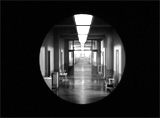
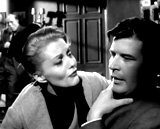
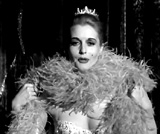
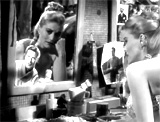

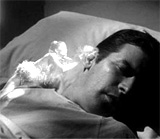


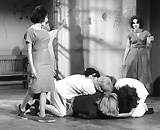
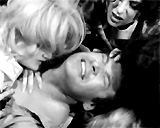



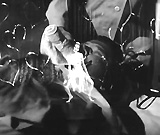
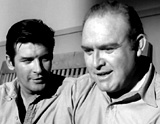
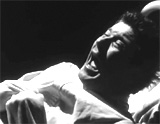
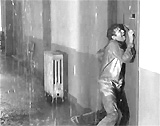
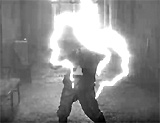
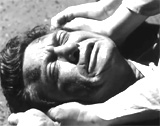
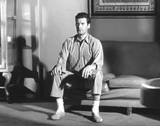
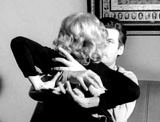
|























